Roccalbegna |
| Roccalbegna dominates the valley of the river Albegna at the slopes of mount Labbro, south of the Mount Amiata. It's about 19 kilometers far from Podere Santa Pia. The village lies on the southern side of the mount Labbro at the confluence between the rivers Armancione and Albegna, for a long time strategic zone for the control on the road that crosses the whole area of the Mount Amiata. Roccalbegna is a singularly positioned village situated above the confluence of Marlancione torrent and Albegna. It leans on two cliffs, il Sasso (stone) or Rocca (rock) to the north and the Cassero of Siena to the south. Sasso is a cliff of app. 60 metres height and almost vertical. You can enjoy an incredible panorama from the top of the cliff, with the houses appearing at the foot of the rock. You can climb up the rock using a path and some stairs. There is a split of the rock in the middle of the way up. It is an entrance (a bit uncomfortable) for a cave from which you can go out to the right, returning back to the halfway of the staircase that leads up to the peak of the Sasso. On the top, there are remains of a small fortress that dominates the village and offers a great panorama; at the roofs of the houses, in front is the Cassero and at the horizon the entire countryside of Maremma. Down to the vilage we found the other cliff, which is dominated by Cassero of Siena. Its construction dates back to the half of the XV century. From here on you may enjoy a great view at the Sasso and the village. There are only two quadrilateral towers and a part of the wall that have remained from the Aldobrandescan fortification strengthened by Siena. The valley of the Albegna river is characterized by some of the most beautiful European canyons. The origin of Roccalbegna is certainly Etruscan. In the Albegna valley, numerous Etruscan graves have been excavated. Furthermore, plenty of local places' names are of Etruscan origin like Albegna, Cana, Valerona. The Chiesa Maggiore dei Santi Pietro e Paolo dating back to the XIII century, is in Romanic style and conserves an altar piece considered to be one of the most significant masterpieces of Ambrogio Lorenzetti. The construction of this religious building dates back to the thirteenth century. Inside some works on canvas by del Tommè and de Salimbeni. The Portal of the Chiesa Maggiore is its most interesting element, the architrave considerably lowered towards the right reveals the yielding the building suffered on that side just a few centuries after its erection. One item of notable importance is a standard from 1799 of the “Viva Maria” bands which opposed the French occupation after the Revolution. In the interior of the Cassero of Siena there is Oratorio del Santissimo Crocifisso (Oratory of the Saint Crucified), presently assigned to a small museum that testifies the value of the artistic property preserved in Roccalbegna. There is a number of sacred paintings preserved here, however the most important one is without doubts the Cross painted by Luca di Tommè which became inserted in the tabernacle of the altar. Roccalbegna is known for its Marzolino di pecora, cheese made from sheep’s milk.
|
||||
 |
||||
Roccalbegna, view from the Rocca Aldobrandeschi [3]
|
||||
Santa Caterina Ethnographic collection
|
||||
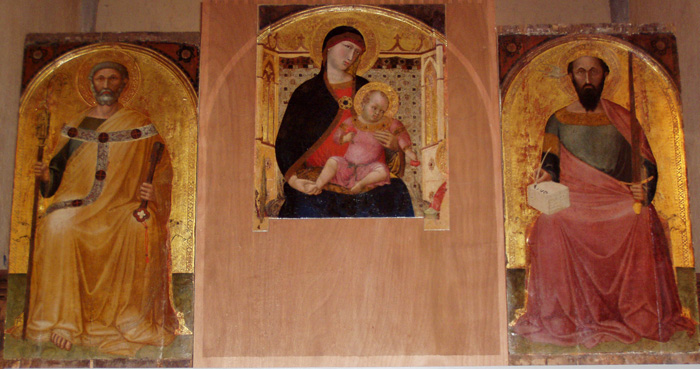 |
||||
Rocchette di Fazio and Semproniano Going down towards Saturnia, shortly outside of Semproniano up on a rock along the Albegna river, rises the medieval village of Rocchette di Fazio, dominated by the ruins of the Rocca Aldobrandesca. |
||||
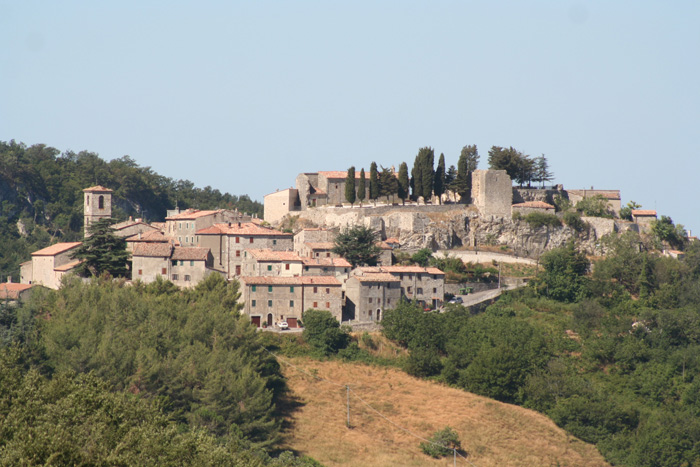 |
||||
Semproniano |
||||
Semproniano is situated just 9 km from Terme di Saturnia, in a hilly territory, between splendid scenes and landscapes of the Maremma Tuscany. With its cultivated countryside, waterways and valleys of the rivers Albegna and Fiora, the village deserves to be visited. From Semproniano the road goes almost consistently uphill to the fork between Petricci and Cellena, both routes go to Triana. When you reach Triana the first sight that impresses is Triana castle (Castello di Triana) which dates back to 776 in documents of the San Salvatore Abbe. The Castello di Triana, 6 kms from the town of Roccalbegna, sits on a rocky promontory and is enclosed by medieval stone walls, whcih are still in remarkably good condition. Outside the walls is the Chiesa San Bernardino alla Triana.
|
||||
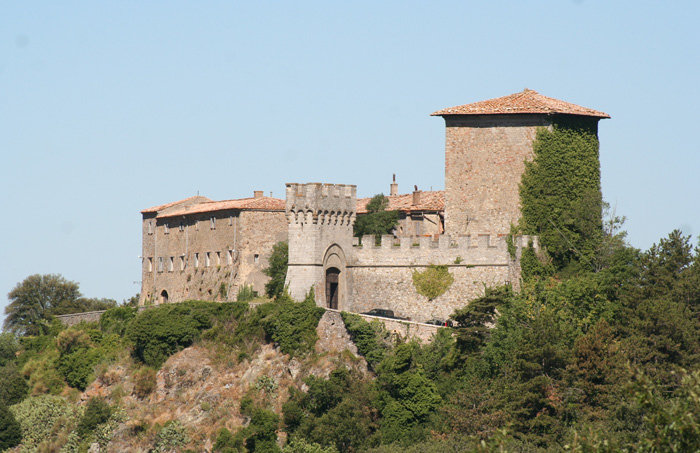 |
||||
Castello di Triana, Roccalbegna [3]
The Focarazza di Santa Caterina is an ancient fire ritual, it's a symbolic celebration held on the eve of the birthday of St Caterina di Alessandrai, in the nearby frazione Santa Caterina. |
||||
| Casefi cio Il Fiorino Between Roccalbegna and Triana there is a wonderful Cheese Factory, ‘Casefi cio Il Fiorino’, specialized in producing the famous Pecorino, which you can taste while you’re there. Caseificio Il Fiorino S.R.L. Localita' Paiolaio - 58053 Roccalbegna (GR) Website Casefi cio Il Fiorino | www.caseificioilfiorino.it |
||||
Alla scoperta della valle dell'Albegna
|
||||
Walking in the surroundings of Semproniano, Roccalbegna and the Albegna valley
|
||||
| The area around Roccalbegna offers some lovely walks among the various nature reserves. Near Roccalbegna, the 1800-acre Riserva Naturale Monte Labbro spreads over the southwesterly slopes of Monte Amiata, offering a spectacular view of the of the typical Tuscan landscape. The Reserve is situated on the north slope of Monte Labro (1.190 m) and represents the northerly limit of the Albegna high valley. Monte Labro is calcareous, has a highly impressive landscape and is of considerable naturalistic interest. This vast area was center of a 19 th century religious movement that sprung up around the controversial figure of David Lazzaretti, a local prophet. The Parco Faunistico dell'Amiata, Mount Amiata Faunal Park is part of Mount Labbro Nature Reserve. It spreads over some 200 hectares and is dedicated to the study, protection and safeguard of a number of animal species semi-wildly living within large areas. In the Nature Reserve, one can follow long guided trails. The Reserve's woods are easily explored on foot, on horseback, or on a mountain bike, by following the network of paths based on the ancient ramblings of mushroom hunters and woodsmen. Directions: take the N 323 from Arcidosso Arcidosso. Follow the directions to Roccalbegna (N 323) and after about 8 km turn right taking the road to Mount Labbro. Follow the directions to the Monte Labbro and Parco Faunistico dell’Amiata. In the area around Roccalbegna, two smaller Nature Reserves, Riserva naturale Pescinello (149 ha) and in river Albegna higher valley the Riserva Naturale di Rocconi. |
||||
Roccalbegna - Semproniano | itinerary 7 |
||||
| The pathway originates in the old town of Roccalbegna and crosses, climbing up and down, a wide stretch of the old Maremma, passing near the localities of Poggio Lago, Podere Rocconi (Reserve of the Rocconi's forest), Podere Ceccherino, La Crocina, and returning then, once passed the Albegna, towards Rocchette di Fazio and Semproniano (this last village can be reached from Rocchette even by the asphalt road). The stretch between Rocchette and Semproniano is also shared by the pathway number 8. This itinerary is a mixture of white pathways and asphalt roads and presents just one demanding stretch, corresponding to the crossing of the Rivo Torrent; the pathway winds up for about 13 km and it can be covered on foot in about 4 hours. We strongly recommend this itinerary as a unique opportunity to admire the wonderful valley of the Albegna river, which is characterized by some of the most beautiful European canyons, as well as to visit the fascinating old town of Rocchette, rare example of a perfectly maintained medieval village situated on overhanging rocks. Three walks take you to Roccalbegna and the hamlets of Triana and Rochette di Fazio, each with their individual features.
Semproniano - Roccalbegna - Triana | 13 km 4 hours From Roccalbegna to Riserva Naturale Pescinello From Roccalbegna to Rocchette di Fazio, 3 uur, marked red and white. From Semproniano to Rocchette di Fazio 1,5 hour, marked red and white. From Rocchette di Fazio to the course of the crystal clear Albegna River. Follow the itinerary to Roccalbegna. Maps | Kompass gide + map nr.653.
|
|
|||
 |
 |
 |
||
Itinerario da Rochette di Fazio verso le gole nell'Albegna |
Veduta del Bosco dei Rocconi da Rocchette di Fazio
|
Le cascate del fiume Albegna a Roccalbegna
|
||
Oasi Affiliata Capra Matilda (Grosseto) (it) In the comune of Roccalbegna, in Cancellone and in the comune of Semproniano, in Selvignana. Riserva Naturale di Bosco Rocconi | The Bosco di Rocconi or “Canyon” Nature Reserve (it) |
||||
|
|
||||
|
Galleria fotografica Monte Amiata
|
||||
| Roccalbegna
|
||||
 |
 |
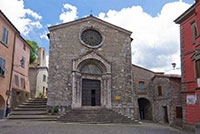 |
||
Panorama Roccalbegna
|
Roccalbegna, veduta dal Cassero
|
Roccalbegna, Chiesa dei Santi Pietro e Paolo, vista dalla Piazza principale
|
||
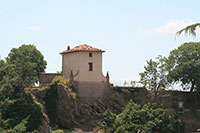 |
 |
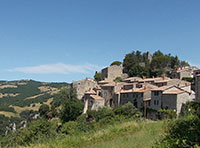 |
||
Cassero senese, Roccalbegna |
Castello di Triana
|
Rocchette di Fazio
|
||
One of Tuscany's best kept secrets is the beautiful valley sheltering this recently renovated 18th century farm house, Podere Santa Pia. This former small cloister is the perfect spot to slow travel. Waking up at dawn to start hiking, learning once again the names of flowers and trees, and above all, having the pleasure of getting lost, forgetting about guides, clocks and timetables.
|
||||
 |
||||
Roccalbegna borders the following municipalities: Arcidosso, Campagnatico, Manciano, Santa Fiora, Scansano, Semproniano.
|
||||
|
Enlarge map Roccalbegna |
||||

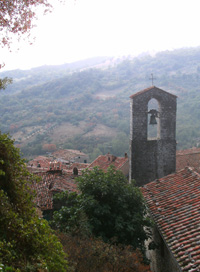

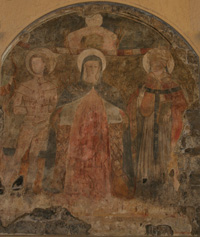
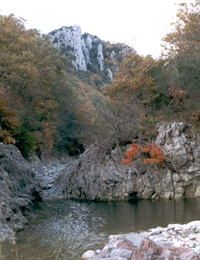

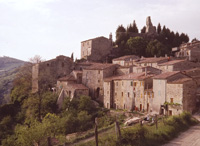 Rocchette di Fazio
Rocchette di Fazio